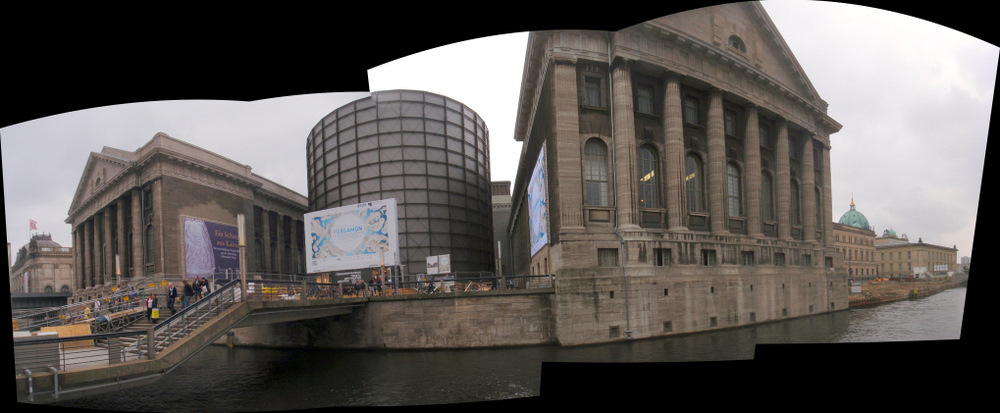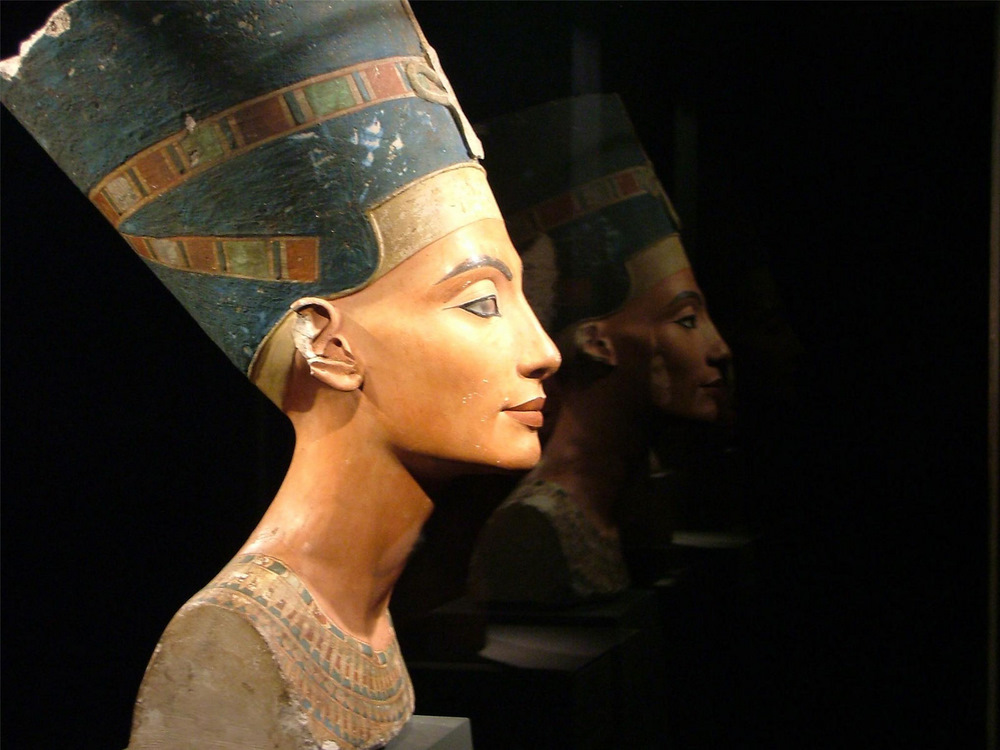| << | 30 | 31 |
| Germany: 1 | 2 | 3 | 4 | 5 | 6 | 7 | 8 | 9 | 10 | 11 | South Tyrol: 12 | 13 | Germany: 14 | 15 | 16 | 17 | Trip Notes | Ray's Pics |
Bicycle Tour Adventure #39: Germany, Day 8
Today, we are going to Sachsenhausen (a lesser known Concentration Camp)
Later we visit Ancient Romans, Egyptians, and Artists at a 4 Museum Complex
We're walking to the Brandenburg Main Train/Subway Station to catch our train ride to the town of Oranienburg. It is about a 25 Kilometer Ride to the north (for about 30 minutes). From there we could catch a bus to the Sachsenhausen Concentration Camp but we are going to walk. The air is heavy today - The skies are cloudy.
Above Right: We're going to ride on a country train, heading north. It is pleasant to see a special designated bicycle car.
Above Right: The city directory signage at Oranienburg. We're following the third sign up from the bottom-right.
It rained on the train for our entire ride, but it stopped raining a minute before we stepped off the train. The rain will actually hold back dust and dander - Terry and I both have allergy issues.
Above Right: Downtown Oranienburg, its colorful.
Above Right: Postal Lady; the German Postal Service is Yellow and they use front loading bicycles with a large easy drop down bipod for parking in an upright position.
Above Right: This display of the Sachsenhausen Concentration Camp shows and explains the layout of the concentration camp. North is to the top. A lot of information is NOT contained in this 3D layout.
- The main camp is triangle shaped with long prison barracks arranged in a horse shoe around the bottom center leg of the triangle.
- The main triangle part of the camp contained Jews, Criminals, Homosexuals, and Communists.
- There were high ranking POWs and Political Prisoners at the Camp but NOT inside the triangle.
- There were many lower ranked Russian POWs that were, apparently mixed right into the main slave population.
- Of the 30,000 humans that died at Sachsenhausen, 10,000 of them were Russian POWs and 100 of them were Dutch Resistance Fighters (to include the people that helped downed Allied pilots escape).
The following description is counter-clockwise from about the 7-8 O'clock position of the central Triangle: - The area that is cordoned off to the southwest in the Big Triangle was the Arrival and Processing Center.
- The center of the south wall of the triangle was the main Prisoner and Guard entrance, with a sign, Arbeit Macht Frei, that means something like 'Work hard to be Free'.
- Outside of the triangle and to the South were the Guard and SS barracks and Housing (probably for Officers).
- Inside the triangle and to south east was the on-site SS barracks (probably for Enlisted).
- Outside of the triangle and due east were the Political Prisoners (not shown on the map), who did know about the concentration camp.
- Outside of the triangle and to the (northeast) or upper right were High Ranking POWs. The POWs never knew about the Concentration Camp.
- The monument inside the north end of the triangle was created by the Communists for fallen Communist Political Prisoners.
- Outside of the triangle and to the northwest was an initial burial place and later extermination ovens were added (but they still ran out of room and had to use other places in the camp area for burials). I can barely write this information.
- Outside of the triangle and to the west was a factory and shipping facility that used free camp prisoner labor.
- Inside the triangle and to south west side were two infirmary buildings. Only one half of one building was for medical treatment.
Above Right: Main Entrance to Sachsenhausen (for Guards and Prisoners) - An Sign on the entry gate, Arbeit Macht Frei, means something like 'Work hard to be Free'
This camp had many types of prisoners: Jews, Criminals, Homosexuals, Communists, Foreigners, Russian POWs, and High Ranking Allied POWs (non-Russian), Resistance Fighters and Political Prisoners (people whose known death would create martyrs or political problems among Nazi Axis Partner Countries). The main camp consisted of Jews, Criminals, Homosexuals, Communists, Russian Soldiers, and other Foreigners. The High Ranking (non-Russian) POWs were kept separate and never knew about the Concentration Camp or Exterminations. The Political Prisoners knew about the Concentration Camp but were kept separate. As I understand it, Russian soldiers were treated in the class of Communists.
Common Criminals (rapists, murderers) wore no ID; Communists wore Red Triangles, Homosexuals wore Pink Triangles, and Jews wore Yellow Triangles.
- This Camp also served as a training center for the Schutzstaffel (SS) Officers, who would be sent to other camps.
- I think that only two people ever escaped, both were Political Prisoners and both used bribery involving guards.
Above Right: A remaining prison barracks and empty pads where other barracks once existed.
Above Right: The boot exercise/test yard. Walking breaks consisted of calisthenics. The worst job was testing military boots - no one cared about boot fit or foot size.
Above Right: Monument to Communist Political Prisoners and Russian Prisoners. The Soviet Army Liberated this Prison. The GOOD NEWS is that the Russians actually took good care of all of the remaining infirmed prisoners. The BAD NEWS is that the Communist Party used this Prison for another Ten Years for their Political Prisoners.
Above Right: The Factory and Shipping Distribution Center. The best job was working in the factory. Prisoners inside the Triangle lived on average one year.
Above Right: Extermination Ovens - Ethnic Cleansing - My Beliefs are Better than Your Beliefs - God is with us - Hate.
Above Right: Back to the main entrance. After the war, a Survivor stated that there were other mass graves. The authorities dug and found them. There are SIX mass grave trenches to the right side of this picture, all filled with murdered victims. Others exist in and around the Concentration Camp.
- We take a 30 minute, very quiet train ride back to Berlin.
- We will make a train transfer and have a redeeming lunch to re-fuel our souls in Berlin.
- The Museums are next to one another on an island in the middle of the Spree River.

Above Right: One of the friezes from the other side.
Above Left: Model of the Ishtar Gate. The museum has the entire double gate but shows the face of just one gate
Above Right: It is difficult to see the scale here but the content of this image is probably 4 M/Yds Tall by 6 M/Yds Wide; there in another Lion Wall image 2 rows down.
Above Right: Close up of one segment of the stone's writing.
Above Right: I am curious about the Eagle Symbol.
Above Right: The first stone column that I have ever noticed that was build to hold wood beams (like the stone version of an umbrella like roof support).
Above Right: Copy/Sample Mosaic Tile Plastering/Finishing [Micro View].
Nefertiti/Egyptian

We were not allowed to take pictures, so I found this image on the Internet which looks almost exactly like what we saw inside a glass case - This image is from http://wallpapers.free-review.net/63__Nefertiti.htm
Old, Classic, and Imppresionistic Oil Paintings and Sculptures
Above Right: Close up on the horse statue.
Above Right: Iron Track with inside rail.